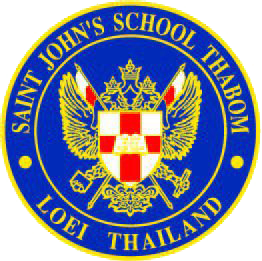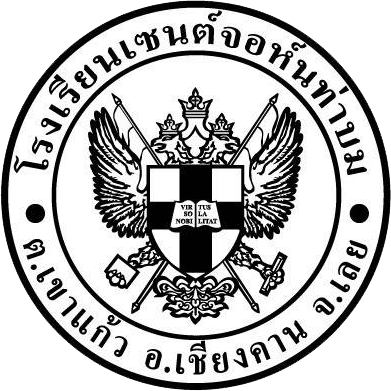ประวัติความเป็นมาของโรงเรียน
ในปีพ.ศ. ๒๕๐๔ อาจารย์สมัย ชินะผา ได้เริ่มก่อตั้งสถานศึกษาที่ให้ชื่อว่า โรงเรียนเซนต์จอห์น กรุงเทพมหานคร และต่อมายังได้ก่อตั้งโรงเรียนเซนต์จอห์น Commerce (ตรีนิติ) โรงเรียนเซนต์จอห์นพณิชยการ โรงเรียนเซนต์จอห์นเทคนิคกรุงเทพ โรงเรียนเซนต์จอห์นอาชีวะศึกษา โรงเรียนนานาชาติเซนต์จอห์น วิทยาลัยเทคโนโลยีเซนต์จอห์น และมหาวิทยาลัยเซนต์จอห์น
อาจารย์สมัย ชินะผา เป็นครูผู้เปี่ยมด้วยประสบการณ์ทางการศึกษาจากการเป็นครูและต่อมาได้รับแต่งตั้งเป็นครูใหญ่ของโรงเรียนเซนต์คาเบรียล ระหว่างที่ทำงานเป็นครู ท่านได้ศึกษาที่จุฬาลงกรณ์มหาวิทยาลัยด้วย จนที่สุดสำเร็จการศึกษาได้รับพระราชทานปริญญาครุศาสตร์บัณฑิตและอักษรศาสตร์บัณฑิต หลังจากนั้น ท่านได้รับทุนของบริติชเคาน์ซิลไปศึกษาต่อที่สถาบันศึกษาศาสตร์ มหาวิทยาลัยลอนดอน
ท่านเป็นครูที่เปี่ยมด้วยจิตวิญญาณของการเป็นครู และมีความปรารถนาที่จะให้ความช่วยเหลือเด็ก ๆ โดยเฉพาะอย่างยิ่งเด็กที่ยากไร้ให้มีโอกาสได้รับการศึกษาที่ดีอย่างที่ท่านได้รับ ในที่สุด ท่านได้ลาออกจากโรงเรียนเซนต์คาเบรียล เพื่อมาจัดตั้งโรงเรียนเซนต์จอห์นจนเจริญเติบโตเป็นโรงเรียนที่มีชื่อเสียงแห่งหนึ่งของประเทศไทย โดยจัดการศึกษาตั้งแต่ระดับชั้นอนุบาลจนถึงปริญญาเอก
ในปี พ.ศ. ๒๕๓๘ คณะซิสเตอร์อัสสัมชัญ ได้เริ่มเข้าทำงานที่โรงเรียนเซนต์จอห์น คณะซิสเตอร์อัสสัมชัญเป็นคณะนักบวชหญิงที่ก่อตั้งขึ้นที่ประเทศฝรั่งเศสโดย นักบุญ มารีย์ ยูจีนี มิเลอเรต์ เดอโบร มีกิจการของคณะอยู่ใน ๓๕ ประเทศ ใน ๔ ทวีป ซิสเตอร์อัสสัมชัญที่ทำงานในประเทศไทยมาจากประเทศฟิลิปปินส์ โดยพวกแรกเดินทางมาตามคำเชิญของพระคุณเจ้าเปโตร คาเร็ตโต แห่งสังฆมณฑลสุราษฎร์ธานีในปี พ.ศ. ๒๕๓๓
งานหลักของคณะซิสเตอร์อัสสัมชัญ ได้แก่งานด้านการศึกษาโดยทำกิจการโรงเรียน ศูนย์ฝึกอบรมเยาวชน ทั้งเด็กและผู้ใหญ่ ศูนย์พัฒนาบุคลากร ศูนย์คำสอน งานอภิบาลในโรงเรียน การเข้าเงียบ และการเจริญชีวิตฝ่ายจิต
ในประเทศฟิลิปปินส์ คณะซิสเตอร์อัสสัมชัญมีกิจการโรงเรียนของตนเองอยู่ทั่วประเทศ รวมทั้งช่วยดูแลกิจการโรงเรียนของโบสถ์และสังฆมณฑลอีกด้วย คณะซิสเตอร์ยังได้ทำงานร่วมกับคณะนักบวชอื่น ๆ เช่นคณะเยซุอิตในมหาวิทยาลัย ผู้เข้ารับการศึกษาจากคณะซิสเตอร์มาจากสถานะต่างๆ ในสังคม ในขณะที่เด็กที่มาเรียนหลายคนมาจากครอบครัวที่มีฐานะทางเศรษฐกิจดี ซิสเตอร์ก็ได้ช่วยให้การศึกษาแก่เด็กที่ยากจนจำนวนมาก เช่น เด็กยากไร้ในสลัม และเด็กยากจนในชนบทด้วย
ในปี พ.ศ. ๒๕๔๐ ได้มีการจัดประชุมใหญ่ทางการศึกษาของคณะซิสเตอร์อัสสัมชัญในเอเชีย โดยจัดขึ้นที่กรุงมะนิลา ประเทศฟิลิปปินส์ ได้มีผู้เข้าร่วมประชุมของคณะจากญี่ปุ่น อินเดีย ไทย และฟิลิปปินส์ เพื่อประเมินประสบการณ์ด้านการศึกษา ไตร่ตรอง และวางแผนสำหรับอนาคต ผู้แทนจากประเทศไทย มี ๓ ท่าน ได้แก่ ซิสเตอร์ ๒ ท่าน และอาจารย์ชัยณรงค์ มนเทียรวิเชียรฉาย ผู้อำนวยการของกลุ่มสถานศึกษาเชนต์จอห์นในขณะนั้น
ในระหว่างการประชุมครั้งนี้เอง ขณะที่ได้ไปเยี่ยมชมโรงเรียนต่าง ๆ ของคณะซิสเตอร์อัสสัมชัญในฟิลิปปินส์ อาจารย์ชัยณรงค์ ได้เกิดความคิดที่จะทำโรงเรียนเช่นเดียวกับที่ได้ไปเห็นที่โรงเรียนอัสสุมตา เมืองปัมปังกา โรงเรียนอัสสุมตาเป็นโรงเรียนที่บรรดาศิษย์เก่าของอัสสัมชัญในกรุงมะนิลาได้ช่วยกันจัดตั้งขึ้นเพื่อช่วยเหลือเด็กชาวไร่ชาวนาในเมืองปัมปังกาที่ยากจนจะได้ไม่ต้องลำบากเดินทางจากหมู่บ้านของตนเพื่อไปเรียนระดับมัธยมที่อื่น
เมื่ออาจารย์ชัยณรงค์เดินทางกลับประเทศไทยก็ได้เล่าประสบการณ์ที่ได้พบเห็นให้แก่คณะกรรมการอำนวยการของโรงเรียนเซนต์จอห์น และเสนอความคิดให้เซนต์จอห์นจัดตั้งโรงเรียนลักษณะเดียวกับอัสสุมตาขึ้นในประเทศไทย เป็นการขอบคุณพระเจ้าโอกาสปึปีติมหาการุณย์ ค.ศ. ๒๐๐๐ คณะกรรมการฯ ของโรงเรียนได้ให้ความเห็นชอบ ปัญหาใหญ่อยู่ที่ว่าโรงเรียนลักษณะเช่นอัสสุมมตา ควรจัดตั้ง ณ ที่ใด
คณะกรรมการฯ ได้มอบหมายให้อาจารย์ชัยณรงค์เป็นผู้รับผิดชอบโครงการนี้โดยได้ติดต่อสอบถามไปยังสังฆมณฑลต่าง ๆ ในประเทศไทย เพื่อขอคำแนะนำเรื่องสถานที่จัดตั้งโรงเรียนสำหรับเด็กในชนบท และได้เดินทางไปดูสถานที่ในจังหวัดต่าง ๆ ทั้งในภาคกลาง ภาคเหนือ และภาคตะวันออกเฉียงเหนือ
วันหนึ่งในขณะที่ประชุมอยู่กับพระคุณเจ้า ยอด พิมพิสาร มุขนายกแห่งสังฆมณฑลอุดรธานี จึงได้เอ่ยถึงโครงการดังกล่าว พระคุณเจ้ายอดจึงแจ้งให้ทราบว่า น่าจะมีสองแห่งที่เหมาะสม คือที่อำเภอชุมแพ จังหวัดขอนแก่น และที่หมู่บ้านท่าบม อ.เชียงคาน จังหวัดเลย ที่น่าสังเกตได้แก่ บ้านท่าบม มีโรงเรียนอนุบาลและประถมของสังฆมณฑลอยู่แล้ว แต่ยังไม่มีโรงเรียนมัธยมสำหรับเด็ก ๆ ในหมู่บ้าน ไม่นานหลังจากนั้น อาจารย์ชัยณรงค์ได้เดินทางไปสำรวจหมู่บ้านท่าบม และเห็นว่าน่าจะเป็นหมู่บ้านแห่งนี้ ในการเดินทางครั้งต่อมา อาจารย์ได้เชิญคณะซิสเตอร์อัสสัมชัญไห้ร่วมเดินทางไปด้วยเพื่อดูความเป็นไปได้ว่า ซิสเตอร์จะสามารถมาช่วยงานโดยมาอยู่ในหมู่บ้านแห่งนี้ และช่วยจัดการศึกษาตามโครงการดังกล่าวได้หรือไม่
ได้มีซิสเตอร์ ๓ ท่านเดินทางมาด้วยกันและพบกับบาทหลวงบัวทอง บุญทอด เจ้าอาวาสในขณะนั้น และบรรดาผู้ใหญ่ในหมู่บ้าน หลังจากได้เดินทางมาเยี่ยมเยียนอีกหลายครั้งพร้อมกับผู้บริหารและครูของเซนต์จอห์น บรรดาซิสเตอร์อัสสัมชัญตลอดจนเพื่อน ๆ ของคณะต่างก็ให้ความสนใจหมู่บ้านแห่งนี้
เดือนพฤษภาคม พ.ศ. ๒๕๔๑ มหาธิการิณีร่วมกับคณะที่ปรึกษา ณ ศูนย์กลางของคณะซิสเตอร์อัสสัมชัญในกรุงปารีส ได้ให้การอนุมัติให้คณะซิสเตอร์ที่กรุงเทพมหานครเปิดบ้านใหม่เพิ่มได้อีกหนึ่งแห่งที่หมู่บ้านท่าบม และอนุมัติให้สามารถทำงานกับเซนต์จอห์นในโครงการโรงเรียนนี้ได้ เริ่มต้นด้วยการช่วยบริหารจัดการโรงเรียนมหาไถ่ศึกษาท่าบม ซึ่งมีการเรียนการสอนในระดับอนุบาลและประถมอยู่แล้ว โดยมีซิสเตอร์ดีน่า มารีอา คอมบอง เป็นอธิการคนแรก
เริ่มเปิดทำการเรียนการสอนระดับมัธยมต้นในปีการศึกษา ๒๕๔๕ โดยขยายจากระดับประถมศึกษาที่มีอยู่แล้วในโรงเรียนมหาไถ่ศึกษาท่าบม มีซิสเตอร์ ๓ ท่าน ช่วยทำงานด้านงานบริหาร งานธุรการ และการเรียนการสอนร่วมกับคณะผู้บริหารของโรงเรียนมหาไถ่ศึกษาท่าบม .มีบัญชีการเงินแยกเป็นอิสระ ได้มีการขยายชั้นเรียนระดับมัธยมเพิ่มขึ้นปีละชั้นเรื่อยมาตามลำดับ ซิสเตอร์ทั้ง ๓ ท่านทำหน้าที่ดูแลแผนกมัธยมเต๊มเวลา และช่วยสอนภาษาอังกฤษ โดยยังให้ความสำคัญด้านการอบรมสั่งสอนนักเรียน และจัดอบรมครูทั้งระดับอนุบาล-ประถม-มัธยมเป็นประจำ ทั้งด้านวิชาการและจิตตารมณ์การเป็นครูอยู่เช่นเดิม
ในขณะเดียวกัน อาจารย์ชัยณรงค์ก็เริ่มมองหาสถานที่ในบ้านท่าบมเพื่อที่จะสร้างโรงเรียนมัธยม โดยการติดต่อขอซื้อที่ดินจากชาวบ้าน ซึ่งอยู่กระจัดกระจายหลายแปลง จนที่สุดได้รวมแล้วกว่าสามสิบไร่ ทั้งที่มีเอกสารสิทธิ์และไม่มีเอกสารใดๆ หลังจากนั้น ได้ติดต่อขอให้สำนักงานที่ดินจังหวัดเลยมาทำรังวัดและออกโฉนดให้ถูกต้อง ซึ่งมีขั้นตอนมากมาย ใช้เวลาทั้งสิ้นรวมแล้วประมาณห้าปี
จนในที่สุดได้เริ่มทำการก่อสร้างอาคารเรียนระดับมัธยมขึ้นในที่ดินที่อยู่เยื้องกับโรงเรียนมหาไถ่ศึกษาท่าบม เป็นอาคารคอนกรีตเสริมเหล็ก ๓ ชั้น เริ่มก่อสร้างเดือนกุมภาพันธ์ พ.ศ. ๒๕๔๖ ครั้นเมื่อก่อสร้างเสร็จเรียบร้อย จึงได้แยกแผนกมัธยมออกมาจากโรงเรียนมหาไถ่ศึกษาท่าบม และตั้งชื่อโรงเรียนใหม่ว่า โรงเรียนเซนต์จอห์นท่าบม เมื่อปีการศึกษา ๒๕๕๐ ต่อมาในปีการศึกษา ๒๕๕๑ ได้เปิดการศึกษาระดับมัธยมปลายสายศิลป์คำนวณและศิลป์ภาษาอังกฤษ หลังจากนั้นได้เปิดสายวิทยาศสตร์เพิ่มขึ้นอีกด้วยเพื่อตอบสนองความต้องการของผู้เรียนและผู้ปกครอง
ปีการศึกษา ๒๕๕๓ นักเรียนชั้นมัธยมศึกษาปีที่ ๖ รุ่นแรก สำเร็จการศึกษา
โรงเรียนเซนต์จอห์นท่าบม เปิดรับนักเรียนชาย-หญิง ไป-กลับ จัดการเรียนการสอนตั้งแต่ระดับมัธยมศึกษาปีที่หนึ่งถึงมัธยมศึกษาปีที่หก จัดการศึกษาตามพระราชบัญญัติการศึกษาแห่งชาติ พุทธศักราช ๒๕๔๒ และแก้ไขเพิ่มเติม (ฉบับที่ ๒ ) พุทธศักราช ๒๕๔๕ และหลักสูตรการศึกษาขั้นพื้นฐาน พุทธศักราช ๒๕๕๑ หลักสูตรท้องถิ่น โดยเน้นผู้เรียนเป็นสำคัญ ใช้กฎ ระเบียบ ข้อกำหนด ตามระเบียบสำนักงานคณะกรรมการการศึกษาเอกชน กระทรวงศึกษาธิการ ยึดถือพระราชบัญญัติการศึกษาโรงเรียนเอกชน พ.ศ. ๒๕๕๐ เป็นแนวปฏิบัติในการจัดการศึกษา
ปัจจุบัน (ปีการศึกษา ๒๕๖๔) ซิสเตอร์ดีน่า มาเรีย วี คอมบอง เป็นอธิการิณีโรงเรียน ซิสเตอร์โซเลดีเนีย เดเวรา ดูแลบัญชีและการเงิน นางกาญจน์ณัฏฐา ศิริเพ็ญ เป็นผู้อำนวยการ มีคณะซิสเตอร์อัสสัมชัญ ๕ คน ครูหญิงจำนวน ๘ คน ครูชายจำนวน ๔ คน บุคลากรทางการศึกษา ๒ คน เจ้าหน้าที่ ๑ คน ภารโรง ๑ คน แม่ครัว ๒ คน รวมบุคลากรจำนวนทั้งสิ้น ๒๓ คน จำนวน นักเรียน ๒๐๒ คน
ปรัชญาของการให้การศึกษาอบรมของคณะอัสสัมชัญที่โรงเรียนเซนต์จอห์นท่าบม ได้แก่ การศึกษาเพื่อให้เกิดการพัฒนาและการเปลี่ยนแปลงในตัวผู้เรียนเพื่อจะได้ช่วยพัฒนาและเปลี่ยนแปลงสังคมที่ดีในวันข้างหน้า การศึกษายังเป็นกระบวนการ “การปลดปล่อยให้ความดีงามซึ่งมีอยู่ในผู้เรียนแต่ละคนได้ทะลุจากหินที่ห่อหุ้มเขาอยู่ ออกมาสู่แสงสว่าง ช่วยให้ความดีงามในตัวผู้เรียนสามารถผลิดอกออกผล และฉายแสงสู่ทุกคนได้”


